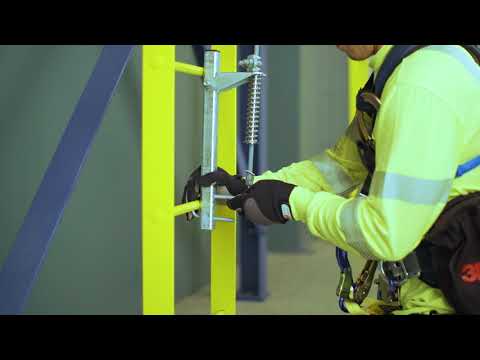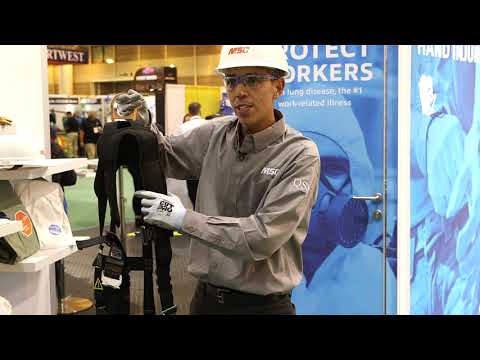Worker fall protection is a serious issue for manufacturers, so it’s worth considering how you can make it easier for your workers to stay safe on the job—whether they use fall protection equipment every day, or only occasionally. We talk to 3M about innovations and tips for using at-height ladder and harness systems.
In many industrial and manufacturing environments, workers might occasionally need a harness and ladder system for at-height work. That makes having a fall protection system that can be shared and is easy to use critical.
“We found the more you make products that workers want to use, are easy to use, are comfortable to use, and don’t reduce their productivity, the more likely they are going to want to use them,” says Tim Thompson, global new product introduction marketing manager for fall protection at 3M. “That alone helps a safety manager.”
In the area of vertical safety, 3M has tackled that challenge by continuing to innovate its Lad-Saf ladder system and its line of 3M DBI-SALA Delta universal harnesses.
“What people misunderstand sometimes is that fall protection is not about one product,” Thompson says. “It’s about a system, combined with education and training.”
Learn more about 3M fall protection in these articles on Better MRO.
The Unique Challenges of Fall Protection
Fall protection continues to be a challenge for businesses and their safety teams. It has been the top-cited violation by the Occupational Safety and Health Administration (OSHA) for nine years, and the provision of fall protection training ranked eighth last year on the OSHA Top 10 violations list.
Fall protection is different than other safety challenges, Thompson says.
“We’re not necessarily trying to solve for protection of a body part,” he explains. “If you think about eyewear, you put the eyewear on and your eyes are protected. You put gloves on; your hands are protected. But with fall protection, it’s not just about making sure products fit on the person. They also have to fit an ever-changing application or an ever-changing worksite.”
That’s obvious on a construction site where the work changes, sometimes radically, from day one until a project is complete. But it’s also true in many manufacturing and production facilities where jobs change and line work evolves throughout a day, a week or over months.
“The protection has to adapt to that change,” Thompson says. “The education and training that goes along have to answer: ‘How do I use this product appropriately as my job site is changing?’ That’s what makes fall protection challenging.”
How that plays out for safety managers, and for ensuring that they can address their top issue—making sure their whole crew remains safe and goes home at the end of a shift—is through personal protective equipment and fall protection gear that’s not overly complex or extremely challenging to use.
That’s how safety managers can “feel better about the overall safety of their workers,” Thompson says.
Rethinking Fixed Ladder Fall Protection Systems
At 3M, a focus on science as part of product evolution is evident in recent upgrades to the company’s Lad-Saf line of vertical fall protection products, which are used for working at height from a ladder.

3M re-envisioned its flexible cable Lad-Saf system so that it would be easier and quicker to install.
The OSHA final rule on fixed ladders, issued in 2017 as part of its General Industry Walking-Working Surfaces and Fall Protection Standards, “phases in a requirement for employers to have ladder safety or personal fall arrest systems for fixed ladders that extend more than 24 feet, and phases out the use of cages or wells for fall protection.”
Those changes, in part, led 3M to develop its ladder safety products, which it does both through R&D in 3M labs and also by listening to its customers every day, Thompson says. “One of the things we heard about our Lad-Saf system, even going back to the legacy versions, is that it could be complicated and time-consuming to install.”
The system is designed for use on varying ladders and for different heights, which affects the total install time. Even so, when 3M looked at the older version of the system, “it came down to reducing the complexity and reducing the parts,” Thompson says.
Engineers came up with a version with far fewer components, up to 72 percent fewer in fact. “That means there aren’t as many tools used to install it, and there isn’t as much room for error in the installation,” he explains. “With fewer loose parts, installation time can be greatly reduced.”

Basically, workers now start with a ladder kit that is half-finished. The goal was to advance safety, but also to improve productivity by saving time, Thompson says.
The engineering team also thought about the changes in terms of creating an adaptable system, he says, for “environments where the product is going to be used for many, many years.”
Find specs for off-the-shelf and custom Lad-Saf flexible-cable, vertical safety systems here.
Envisioning a Harness for Multiple Users
“Our Delta harness is a product where we have really focused on continually innovating and making it easier to use,” Thompson says.
It has a couple of features that make it user-friendly, he says. The first is the no-tangle design. No matter how or where a facility stores its harnesses, or how many workers share a harness, “that no-tangle design allows a user to pick this harness up and easily be able to know how to put it on,” he says.
The Delta harness goes on like a jacket, which helps take any type of tangling out of the process. “It just makes it easier to understand how to don the harness,” Thompson says, which can be critical if a user, even when properly trained and certified to use a harness, only uses one sporadically.

The universal-fit 3M Delta harness has a weight capacity of up to 420 pounds.
Second, the Delta has revolving torso adjusters, which 3M also has on some of its other harnesses. These make it easy to adjust and hold the proper fit, he says.
The other aspect of the harness that makes it a good choice for a wide range of industrial uses is its durability.
These three design elements are critical in ensuring that someone will be wearing a safety harness, Thompson says. “The safety manager knows they have a product that their workers are likely to use and to put on properly.”

A Delta harness can be adjusted for multiple people to wear at different sizes because of its universal sizing.
For instance, what happens without universal sizing if a worker comes to get a harness from the tool crib and only small harnesses are available? “If it’s not fitted correctly, there can be a safety issue,” Thompson says. “The universal-size harnesses can fit a wide range of users but still be adjusted appropriately so those users have a safe fit while they’re working.”
That can be a critical factor in a manufacturing environment. These facilities are not necessarily akin to a construction site, where some workers might wear a harness every day, all day.
“That’s why the Delta harness is popular in the manufacturing segment,” Thompson says. A company doesn’t have to invest in protective gear that might sit unused. “In a manufacturing and industrial environment, you can have easy adjustments, you can fit multiple sizes.”
The Delta also has a high capacity, up to 420 pounds, allowing for a broad range of users that the harness can accommodate.
“One of the things 3M has focused on since the very beginning of the company is that if the product is not easy to use, the customer is not going to use it,” Thompson says. “Ultimately, it doesn’t matter how you build a product from a robustness standpoint if it’s not going to work easily when a customer needs it to work.”
Do your workers share fall protection equipment? Share best practices you have learned that work well in your facility.
How to Select Fall Protection Equipment for Your Workers
Before you invest in harnesses for your facility, here are three considerations that should affect your product evaluation process.
Time of use: How long will a worker be wearing the harness during a shift?
Some workers might need their own harnesses if their job requires them to work at height for long periods, and you might want to use harnesses that are sized specifically for those workers.
Number of users: Are workers going to share harnesses?
If so, universal-sized harnesses might be ideal. But you’ll want to determine how many you need based on anticipated workload demands.
Type of use: What is the specific application?
“When it comes to the specific application, you will want to look at the configuration,” explains Tim Thompson, who manages new product introductions for fall protection at 3M. “That has to do with the types of buckles and where you will have D-rings.”
For vertical ladder climbing, when paired with a ladder system, you’re going to need a front D-ring for attachment. All harnesses have a dorsal, or back, D-ring.
If you are working off of a ladder—climbing vertically and then working while on the ladder—you’ll want front, back and side D-rings, along with a work-positioning device “so that you can let go of the ladder with your hands and do your work.”
That way your workers will have agility at height but still be safe.
Related Articles

Safety Audits: A Powerful Tool to Protect Workers

Master Lock Pairs Bluetooth with Padlocks to Boost Workplace Security

Out in the Cold: Tips for Staying Safe

5 OSHA Enforcement Updates: What Employers Need to Know


